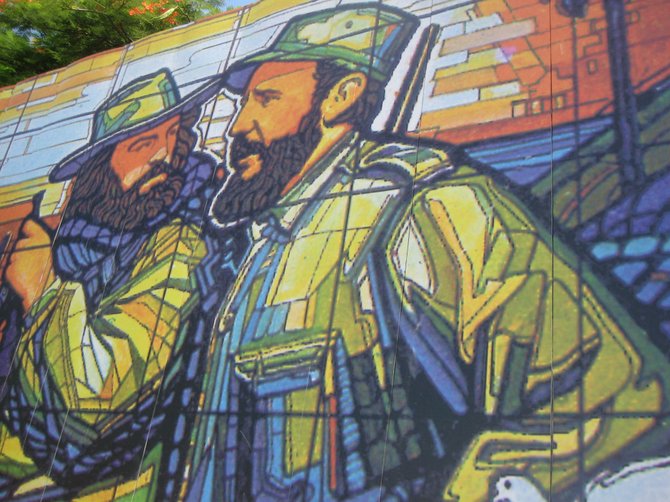 Facebook
Facebook
 X
X
 Instagram
Instagram
 TikTok
TikTok
 Youtube
Youtube

“Is Levi or Guess considered a more elegant brand? Addidas or Reebok?” A couple of mid-twenties locals ask with anticipation.
A young single mother shares her ideas on the “What is Cuba to you?” question for a few minutes, detailing hardship and frustration. She caps off her thoughts with, “I hate Cuba.”
Outside the extremes of those Cubans directly involved in the tourist industry and those older generations accustomed to waiting on Fidel’s promises and visions, there lives another Cuba. These Cubans yearn to form their own realities, to express themselves, to be given opportunities. They want to know what’s happening in the world beyond their borders – and many of them want to take part in it.
Posted ubiquitously around Havana are drawings depicting scenes from the revolution days or signs reading “Viva La Revolucion.” But this revolution overtook Batista’s dictatorship over 50 years ago. It feels as if the Cuban government is trying to hold on to some strain of loyalty and energy belonging to that long-ago fight. Memories of these times don’t even exist for many from the younger Cuban world. The “revolution” seems to reek of an older Cuban day that has already passed by.
Passion, strife, confusion and waiting fill this community. But with Fidel on his way out – something that will seemingly only happen with his passing – and U.S. restrictions on Cuba being lifted step by step, the wait appears to be shrinking quickly.
Things to Do. Walk around outside of the tourist attractions to meet another “real” Havana. Climb the beautiful entrance steps of the University of Havana – where young Fidel fostered his revolutionary ideas while earning his law degree. Like many universities, it’s teeming with young bright minds to meet. Spend a night at a cabaret such as El Tropical, with locals sweating, smiling and dancing fervently to live music. The pure passion focused on music, dance and letting go is overwhelming.
Where to Stay. Don’t stay in hotels. State-sanctioned accommodations in family homes are fairly abundant. They are called “casa particulares” and have a few advantages for a traveler getting to know this Havana world:
You can meet a Cuban family in their home; many times they’ll offer to cook you meals as well.
The setup is more like an apartment than merely a room (and can come complete with a full kitchen).
The cost is usually around $35 a night, leaving more spending money for other city adventures.
Warnings. It’s sad, but be weary of overly friendly Cubans. The term “jinetero” is given to Cubans who cater to tourists, posing as new friends and aiming to make money. They’re useful to show you restaurants or attractions, but will undoubtedly try to take advantage of the situation. It’s up to you to decide if it’s worth hanging out with people like this, and when to part ways.
More Information. One of the best websites for visitors to Cuba is cuba-junky.com.


“Is Levi or Guess considered a more elegant brand? Addidas or Reebok?” A couple of mid-twenties locals ask with anticipation.
A young single mother shares her ideas on the “What is Cuba to you?” question for a few minutes, detailing hardship and frustration. She caps off her thoughts with, “I hate Cuba.”
Outside the extremes of those Cubans directly involved in the tourist industry and those older generations accustomed to waiting on Fidel’s promises and visions, there lives another Cuba. These Cubans yearn to form their own realities, to express themselves, to be given opportunities. They want to know what’s happening in the world beyond their borders – and many of them want to take part in it.
Posted ubiquitously around Havana are drawings depicting scenes from the revolution days or signs reading “Viva La Revolucion.” But this revolution overtook Batista’s dictatorship over 50 years ago. It feels as if the Cuban government is trying to hold on to some strain of loyalty and energy belonging to that long-ago fight. Memories of these times don’t even exist for many from the younger Cuban world. The “revolution” seems to reek of an older Cuban day that has already passed by.
Passion, strife, confusion and waiting fill this community. But with Fidel on his way out – something that will seemingly only happen with his passing – and U.S. restrictions on Cuba being lifted step by step, the wait appears to be shrinking quickly.
Things to Do. Walk around outside of the tourist attractions to meet another “real” Havana. Climb the beautiful entrance steps of the University of Havana – where young Fidel fostered his revolutionary ideas while earning his law degree. Like many universities, it’s teeming with young bright minds to meet. Spend a night at a cabaret such as El Tropical, with locals sweating, smiling and dancing fervently to live music. The pure passion focused on music, dance and letting go is overwhelming.
Where to Stay. Don’t stay in hotels. State-sanctioned accommodations in family homes are fairly abundant. They are called “casa particulares” and have a few advantages for a traveler getting to know this Havana world:
You can meet a Cuban family in their home; many times they’ll offer to cook you meals as well.
The setup is more like an apartment than merely a room (and can come complete with a full kitchen).
The cost is usually around $35 a night, leaving more spending money for other city adventures.
Warnings. It’s sad, but be weary of overly friendly Cubans. The term “jinetero” is given to Cubans who cater to tourists, posing as new friends and aiming to make money. They’re useful to show you restaurants or attractions, but will undoubtedly try to take advantage of the situation. It’s up to you to decide if it’s worth hanging out with people like this, and when to part ways.
More Information. One of the best websites for visitors to Cuba is cuba-junky.com.
Comments